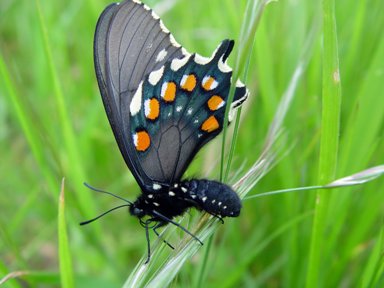Interactions
"What's a butterfly garden without butterflies?" - Roy Rogers
Battus philenor have interactions with plants but also parasitoids, fungi and humans.
Battus philenor larvae has a parasitic relationship with
plants. A parasitic relationship is where one organism benefits while
the other organism is harmed. The females use plants to lay their eggs
on the host plant so when larvae emerge from their eggs they can eat the host plant.
The larvae can potentially kill the host plant by eating all of the
leaves off of the plant. Battus philenor also have a mutualistic relationship with plants. A mutualistic
relationship is a relationship in which both organisms benefit from each other. The flower
benefits because the butterfly pollinates the flowers while the butterfly
benefits because it is getting the nectar from the plants (fcps.edu).
.jpg)
Butterflies can have an interaction with parasitoids. Parasitoids are creatures that feed on other organisms and eventually kill them (Hoskins, n.d.). One example of this would be the minute wasp. The minute wasp will inject their eggs into some butterfly's eggs. This kills the butterfly larvae and the wasp will emerge from the butterfly egg (Hoskins, n.d.). Other types of wasps will spend their larval stage feeding on the inside of the caterpillars body until it emerges, leaving the caterpillar to die shortly after(Hoskins, n.d.). Image courtesy of Wikimedia Commons. the picture above shows freshly-laid Battus philenor eggs that are on the underside of the Virginia Snakeroot (Aristolochia serpentaria) which shows the relationship between the two organisms.
.jpg) Image courtesy of Wikimedia Commons. The image to the left shows Battus
philenor getting the nectar out of a flower by using the proboscis
while pollinating the plant. To learn more about the proboscis go to the
Adaptation page!
Image courtesy of Wikimedia Commons. The image to the left shows Battus
philenor getting the nectar out of a flower by using the proboscis
while pollinating the plant. To learn more about the proboscis go to the
Adaptation page!
Battus philenor eggs have an interaction with animals because some of the eggs get eaten by organisms like ants or birds (Wilson, 2008). The eggs of Battus philenor are not poisonous until the larvae has consumed the host plant. To learn more about the nutrition of the larvae go to the Nutrition page. When Battus philenor is an adult they have a defense mechanism that makes them poisonous to most predators because of the chemicals incorporated into the body as larvae(Mikula, 1997). Since they have this defense mechanism, they do not have many predators when they get to the adult stage because they are distasteful and even deadly to potential predators like birds. To learn more about the defense mechanism of Battus philenor go to Adaptations.
.jpg) Of course, Battus philenor have interactions with humans.
People ruin butterfly habitats for the development and urbanization of
areas and through the use of pesticides. To learn more about the habitat
of Battus
Philenor go to Habitat. Another
interaction Battus philenor have with humans is the simple fact
that people like to observe them. Sometimes people will plant things
like pipevine, Dutchman's pipe, knot weed or other plants in the Family
Aristolochiaceae in their gardens to attract Battus philenor.
Image courtesy of Wikimedia Commons. The image above shows the urbanization of
an area that could have been the home to butterflies.
Of course, Battus philenor have interactions with humans.
People ruin butterfly habitats for the development and urbanization of
areas and through the use of pesticides. To learn more about the habitat
of Battus
Philenor go to Habitat. Another
interaction Battus philenor have with humans is the simple fact
that people like to observe them. Sometimes people will plant things
like pipevine, Dutchman's pipe, knot weed or other plants in the Family
Aristolochiaceae in their gardens to attract Battus philenor.
Image courtesy of Wikimedia Commons. The image above shows the urbanization of
an area that could have been the home to butterflies.
To learn some interesting things about Battus philenor go to Facts.
.jpg)
.jpg)
